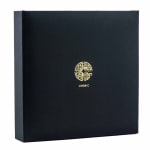Jihan C
Jean Trad Palace Wall Display Box Set
24k gold plated metal facade on black velvet base with wooden black frame
30 x 30 x 6 cm
Copyright The Artist
AED 2,161.90
In Lebanon, the house with triple arches appeared in the second half of the 19th century. The house soon became a favorite of the bourgeois class, and represented a new...
In Lebanon, the house with triple arches appeared in the second half of the 19th century. The house soon became a favorite of the bourgeois class, and represented a new form of urban architecture inspired by elements of Ottoman modernity.
The house was centered on a large central hall or room. It featured a triple arched window, a central element of its design, which opened onto a narrow balcony and a garden, or a street, or landscape.
The Lebanese triple arched window represetned here comes from the Jean Georges Trad Mansion in Beirut's Achrafieh district. Sadly, the house was completely destroyed in 1995. This artwork, based on architectural drawings and photographs, hopes to preserve its legacy for future generations.
The colorful geometric patterned tiles used in residential buildings of the 1920s and 1930s, locally known as "Cemento", were produced in local tile factories, by skilled workers, using cast iron molds and a water press. The "Cemento" tiles in Elie Saab's residence are represented here as the peripheral framing of the artwork.
The house was centered on a large central hall or room. It featured a triple arched window, a central element of its design, which opened onto a narrow balcony and a garden, or a street, or landscape.
The Lebanese triple arched window represetned here comes from the Jean Georges Trad Mansion in Beirut's Achrafieh district. Sadly, the house was completely destroyed in 1995. This artwork, based on architectural drawings and photographs, hopes to preserve its legacy for future generations.
The colorful geometric patterned tiles used in residential buildings of the 1920s and 1930s, locally known as "Cemento", were produced in local tile factories, by skilled workers, using cast iron molds and a water press. The "Cemento" tiles in Elie Saab's residence are represented here as the peripheral framing of the artwork.




